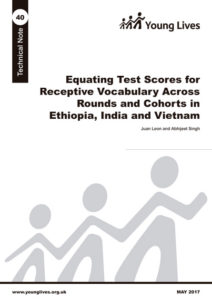Equating test scores for receptive vocabulary across rounds and cohorts in Ethiopia, India & Vietnam
| Year | : | 2017 |
|---|---|---|
| Author/s | : | Juan Leon, Abhijeet Singh |
| Area/s | : | Education and learning |
León, Juan & Abhijeet Singh (2017). Equating test scores for receptive vocabulary across rounds and cohorts in Ethiopia, India & Vietnam. Young Lives Technical Note 40. Oxford: Young Lives.
In longitudinal studies such as Young Lives, getting comparable measures of children´s cognitive abilities over time is essential for identifying individual, household, and school-level factors that affect children´s development. Few longitudinal studies that follow birth/age cohorts include comparable cognitive measures across waves, and those studies that are available are mainly from developed countries. Young Lives provides a unique opportunity to explore the development of value added or growth curve modelling analysis aimed at identifying variables at different levels and across time and space, associated with children’s learning outcomes, in developing countries.
This Technical Note discusses the construction of cognitive scores that are comparable across rounds and age cohorts for Young Lives in Ethiopia, India (the states of Andhra Pradesh and Telangana) and Vietnam.
Young Lives gathers information from children and their families through individual and household questionnaires, including different cognitive and achievement tests. The Peabody Picture Vocabulary Test (PPVT) is the one test that is common across rounds and cohorts. Therefore, this test was selected to build cognitive measures comparable across Rounds 2, 3 and 4, and age cohorts (the Younger Cohort, born in 2001/02, and Older Cohort, born in 1994/95) employing Item Response Theory (IRT) to achieve standardised cognitive measures. Scores were estimated using a three-parameter model which considers the item’s difficulty, discrimination, and pseudo-guessing as parameters to estimate the individual’s ability. The second step was to perform a Differential Item Functioning analysis (DIF) by cohort and survey round in order to identify possible item bias and correct it. The last step consisted of equating the scores of common items (anchor items) as a means of obtaining comparable PPVT scores across rounds and cohorts without cohort and round biases.







